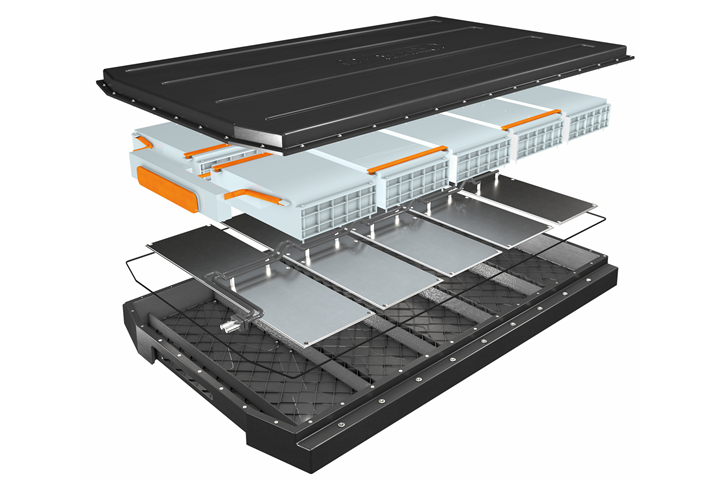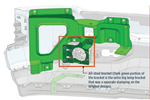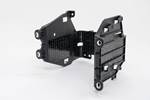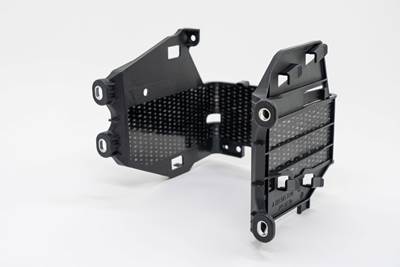Lanxess, Kautex Textron explore D-LFT for EV battery housings
Research cooperation substitutes steel and aluminum with a continuous fiber-reinforced thermoplastic technology demonstrator for advantages in weight, functional integration and mass production.

The demonstrator was developed based on the battery housing of a C-segment electric vehicle (EV). It consists of a housing tray with crash structure, a housing cover and an underrun (underbody) protection. Photo Credit: Kautex Textron GmbH & Co. KG
Specialty chemicals company Lanxess (Cologne, Germany) and Kautex Textron GmbH & Co. KG (Bonn, Germany), a Textron Inc. (Providence, R.I., U.S.) company, have been collaborating for several years to demonstrate the advantages of technical thermoplastics over metals in battery housings for electric vehicles (EVs) in terms of weight and cost reduction, functional integration and electrical insulation behavior Together, the companies have developed a near-series technology demonstrator in the feasibility study. With a length and width of around 1,400 millimeters each, the system is a large-format all-plastic housing part with a weight in the mid-double-digit kilogram range.
“As a first step, we have completely dispensed with the use of metallic reinforcement structures while proving we can commercially produce these complex, large components,” explains Felix Haas, director, product development, at Kautex Textron. Going forward, Kautex and Lanxess want to use the results of the cooperation to enter into development projects for series production with automotive manufacturers.
The demonstrator was developed based on the battery housing of a C-segment EV. It consists of a housing tray with crash structure, a housing cover and an underrun (underbody) protection. The housing components can be produced in a single-stage, direct long fiber thermoplastic (D-LFT) molding process. Lanxess has optimized its Durethan B24CMH2.0 PA6 resin as the material for the D-LFT molding compound; Kautex Textron compounds the PA6 for the process with glass fiber rovings. Lanxess’ Tepex dynalite continuous fiber-reinforced thermoplastic is applied as reinforcement for the housing structure. “The process enables shorter and thus more economical cycle times than the processes in which steel or aluminum are processed,” Haas explains.
Today, says Lanxess, housings for high-voltage batteries are primarily made of extruded steel or aluminum profiles. Depending on the vehicle class, the housing length and widths can be well over 2,000 or 1,500 millimeters, respectively. The size, the number of components and the numerous manufacturing and assembly steps make metal housings very cost intensive. For example, complex structures made from strand press profiles require many secondary work steps such as welding, punching and riveting. In addition, the metallic components must be protected against corrosion in an additional process step by cathodic dip coating.
“Plastics, on the other hand, can fully exploit their design freedom. By integrating functions such as fasteners and thermal management components, the number of individual components of a battery housing can be greatly reduced. This simplifies assembly and logistical effort, which reduces production costs,” says Dr. Christopher Hoefs, project manager e-Powertrain at Lanxess.
High-voltage battery housings must also meet a variety of highly demanding technical requirements, including high stiffness and strength, energy absorption in the event of a crash, flame retardancy and integration of the housings in the vehicle structure, to name a few. Lanxess reports that plastics have the potential to meet many of these needs. The material is corrosion resistant and electrically insulating, the latter of which ensures a reduced risk of the system short-circuiting. The low density of plastics and their potential for lightweight construction also lead to significantly lighter housings, which benefits, among other things, the range of EVs.
“We continue to work together on optimizing the production and structural design of the components. The aim is to carry out the majority of the development work virtually, in order to save costs in prototype design and to shorten the time to market of future series components,” Hoefs says.
Related Content
Bcomp ampliTex makes appearance in Cupra EV Cup Bucket seats
The entire Cupra Born VZ line-up features all-natural fiber front seats that highlight functionality, aesthetics and reduced CO2 emissions.
Read MoreThe new Slate truck costs less than $20,000, uses PP composite body panels
Stylish vehicle EV pickup model is supported by a simplified manufacturing process. It is also capable of customization from two seats to five seats.
Read MoreTrinseo demonstrates DLFT, PC for electric vehicle battery packs
The DLFT production process enhances polycarbonate’s performance qualities through high thermal stability that next-gen battery packs demand.
Read MoreSpanish startup to ramp up production of “recyclable” EV prototype
Liux’s BIG electric vehicle features multiple structural components manufactured via RTM from flax fabric and a thermoset resin said to enable the entire component to be recycled and reused again.
Read MoreRead Next
Thermoplastic composites: Structural bumper bracket
Hybrid bracket reduces mass, increases design flexibility, package space in pickup front bumper.
Read MoreLanxess demonstrates Tepex composite material in structural bracket application
Lightweight bracket offers firm clamping of batteries in Mercedes-Benz S-Class with high strength under sustained dynamic stress, functional integration and no risk of short circuiting.
Read MoreCeramic matrix composites: Faster, cheaper, higher temperature
New players proliferate, increasing CMC materials and manufacturing capacity, novel processes and automation to meet demand for higher part volumes and performance.
Read More




















